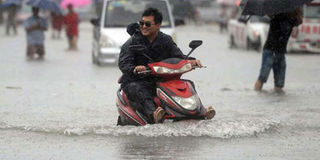Premium
300 dead or missing as floods sweep through northern China

A man makes his way through a flooded street on a scooter in Beijing on July 20, 2016. Torrential rain lashing northern China in the past week has left nearly 300 people dead or missing and displaced hundreds of thousands, official media reported on Monday. PHOTO | AFP
What you need to know:
- As of Monday morning more than half a million people in the hardest-hit provinces of Henan and Hebei had been displaced, with 125,000 people in urgent need of basic assistance.
- Locals accused authorities of failing to warn them of the impending deluge and trying to cover up the cause of the disaster.
- Earlier this month heavy downpours wreaked havoc in central and southern China, flooding several major cities and causing over 200 deaths.
BEIJING
Torrential rain lashing northern China in the past week has left nearly 300 people dead or missing and displaced hundreds of thousands, official media reported on Monday.
As of Monday morning more than half a million people in the hardest-hit provinces of Henan and Hebei had been displaced, with 125,000 people in urgent need of basic assistance, said Xinhua news agency, citing the Ministry of Civil Affairs.
The storms have left 164 dead and 125 missing, it added.
Five officials had been suspended as of Monday for dereliction of duty during a devastating flash flood last week near the town of Xingtai in Hebei.
The incident, which left at least 25 dead and 13 missing, provoked outrage.
Locals accused authorities of failing to warn them of the impending deluge and trying to cover up the cause of the disaster. Flooding is not uncommon during the summer monsoon season in northern China, but rain has been unusually heavy across the country this summer.
Earlier this month heavy downpours wreaked havoc in central and southern China, flooding several major cities and causing over 200 deaths.
Meanwhile, Southeast Asian nations today ducked direct criticism of Beijing over its claims to the South China Sea, in a diluted statement produced after days of disagreement that gives the superpower a diplomatic victory.
The 10-member Association of Southeast Asian Nations (ASEAN) avoided mention of a ruling by a UN-backed tribunal in early July that rejected China’s territorial claims and infuriated Beijing.
Instead, ASEAN, gathered in the Laos capital Vientiane for the first time since the ruling, called for “self-restraint” from all parties in the strategic waterway in a soft statement that edged away from a showdown with regional powerhouse China.
INCREASING TENSION
The contested sea, through which some $5 trillion in shipping passes annually, has been a source of increasing tension between China and its Southeast Asian neighbours along with the United States.
The Philippines launched the legal challenge against China which claims vast swathes of the waters, including areas approaching its coasts and other Southeast Asian nations.
Three other members of the bloc — Vietnam, Malaysia and Brunei — also have competing claims with Beijing over parts of the South China Sea.
But the statement that finally emerged after days of wrangling has exposed deep divisions within the regional grouping.
With the bloc faltering in its response to the region’s major security challenge of the day, analysts say it risks becoming a talking shop lacking in diplomatic clout.
Staunch Beijing ally Cambodia has been accused of scuppering efforts by the bloc to unite in a call for China to abide by the tribunal’s verdict.
While most members want to keep pressure on China over its campaign of island-building in the contested water, they are wary of angering such a vital trading partner.
“With Cambodia marching to its own drum the erosion of ASEAN solidarity is on display for all to see,” regional expert Carl Thayer told AFP.





